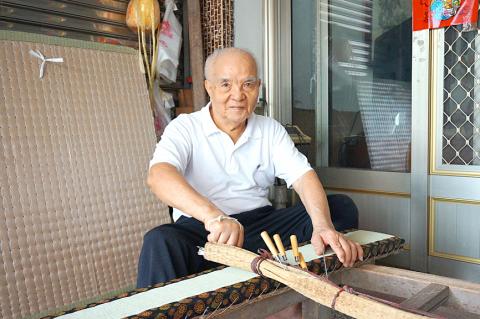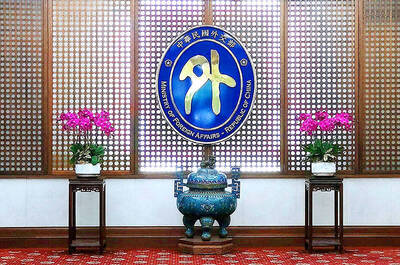Chiu Po (邱波), 85, runs one of two remaining businesses in Chiayi County that insist on weaving tatamis by hand.
Chiu said he left Chiayi’s Meishan Township (梅山) to develop his skills in Jhuci Township (竹崎) when he was 16 years old because of family circumstances.
Chiu opened his own tatami business when he was 26 years old.

Photo: Tseng Nai–chiang, Taipei Times
Jhuci is on the Alishan Forest Railway route, so many Japanese-style hotels opened in the area for lumberjacks and tourists, Chiu said.
Most tatamis at the time were bought by hotels to repair or replace existing ones, he added.
Demand for tatamis sharply decreased in the 1980s with the rise of spring mattresses, Chiu said, adding that Japanese-imported bases made of compressed wood chips or polystyrene foam, which are waterproof and durable, were also introduced.
A tatami has a straw base in the middle layer which is made by placing rice straw horizontally and vertically in five layers to create thickness.
Minhsiung Culture and Education Foundation humanistic photography teacher Wei San-feng (魏三峰) said the smell of rice straw reminds him of his childhood.
Wei, whose students photographed Chiu’s handcraft, said that a tatami is neither too soft or firm and can be laid flat or folded, making it very versatile.
“As long as you put your heart into the work and insist on quality, you do not have to worry about customers not returning,” Chiu said.
Cheng Shun-hsing (鄭順興), 61, retired from his job as a physical therapist at Puzi Hospital two years ago and inherited his father’s tatami business in Puzi City (朴子).
Echoing Chiu, Cheng said the majority of tatami mats are sold to families rather than hotels.
Cheng said he has developed pillows, support pillows, coasters and other products.
The exterior of the pillow is made with foam while the middle layer is rice straw, Cheng said, adding that body heat is released through the straw making the pillows breathable.
Years of squatting to weave tatami have caused pain in Chiu’s lower back and hands, he said, adding that he has undergone cataract surgery, but he is unwilling to retire and regrets that there is no one to inherit the craft.
Cheng also wishes to pass on his skills and has taught people how to make tatami at community centers in Lioujiao Township’s (六腳) Wanbei Village (灣北) and Puzi City’s Shuntian Village (順天).
Wei said that a photography exhibition at the Chiayi District Prosecutors’ Office in March next year would show the process of tatami making.

The Ministry of Foreign Affairs (MOFA) yesterday voiced dissatisfaction with the Comprehensive and Progressive Agreement for Trans- Pacific Partnership (CPTPP), whose latest meeting, concluded earlier the same day, appeared not to address the country’s application. In a statement, MOFA said the CPTPP commission had "once again failed to fairly process Taiwan’s application," attributing the inaction to the bloc’s "succumbing to political pressure," without elaborating. Taiwan submitted its CPTPP application under the name "Separate Customs Territory of Taiwan, Penghu, Kinmen and Matsu" on Sept. 22, 2021 -- less than a week after China

ALIGNED THINKING: Taiwan and Japan have a mutual interest in trade, culture and engineering, and can work together for stability, Cho Jung-tai said Taiwan and Japan are two like-minded countries willing to work together to form a “safety barrier” in the Indo-Pacific region, Premier Cho Jung-tai (卓榮泰) yesterday said at the opening ceremony of the 35th Taiwan-Japan Modern Engineering and Technology Symposium in Taipei. Taiwan and Japan are close geographically and closer emotionally, he added. Citing the overflowing of a barrier lake in the Mataian River (馬太鞍溪) in September, Cho said the submersible water level sensors given by Japan during the disaster helped Taiwan monitor the lake’s water levels more accurately. Japan also provided a lot of vaccines early in the outbreak of the COVID-19 pandemic,

Kaohsiung Mayor Chen Chi-mai (陳其邁) on Monday announced light shows and themed traffic lights to welcome fans of South Korean pop group Twice to the port city. The group is to play Kaohsiung on Saturday as part of its “This Is For” world tour. It would be the group’s first performance in Taiwan since its debut 10 years ago. The all-female group consists of five South Koreans, three Japanese and Tainan’s Chou Tzu-yu (周子瑜), the first Taiwan-born and raised member of a South Korean girl group. To promote the group’s arrival, the city has been holding a series of events, including a pop-up

A home-style restaurant opened by a Taiwanese woman in Quezon City in Metro Manila has been featured in the first-ever Michelin Guide honoring exceptional restaurants in the Philippines. The restaurant, Fong Wei Wu (豐味屋), was one of 74 eateries to receive a “Michelin Selected” honor in the guide, while one restaurant received two Michelin stars, eight received one star and 25 were awarded a “Bib Gourmand.” The guide, which was limited to restaurants in Metro Manila and Cebu, was published on Oct. 30. In an interview, Feng Wei Wu’s owner and chef, Linda, said that as a restaurateur in her 60s, receiving an